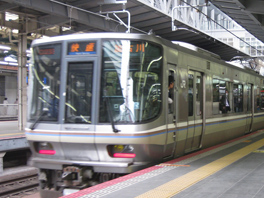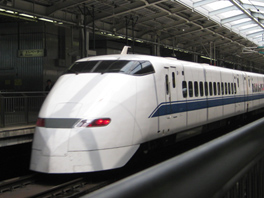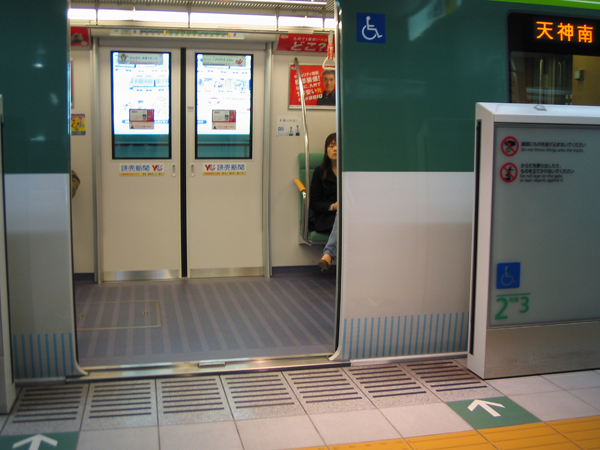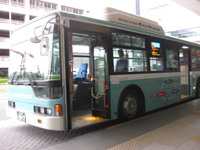
|



 |
|

|
Railway is a major public
transportation for Japanese people and has a very well established network
nationwide. You will also find them very accessible; ramps,
escalators, and elevators are available at major stations. Train car
floors and platforms are usually level, making it easier to get on and off the
train. In some rural cities, however, you may find lower accessibility.
Some express trains do not have enough wheelchair space or seats.
And some stations do not have elevators, but if you are on a manual
wheelchair, you can help yourself to the escalators, or ask the station staff
to help you out. Be reminded that Tokyo metropolitan area can get
extremely crowded during morning and evening peak hours, sometimes too
dangerous to move around in wheelchairs.

|
 |


 |
|

|
Shinkansen ( bullet train ) is
the fastest and the most convenient express train in Japan, and
all stations are wheelchair accessible. Elevators on platforms are available for all passengers.
Train car floors and platforms are almost level, but train
doors are not so wide 71cm. The
aisle width is 57cm. They have a wheelchair friendly
coach (#11 of Tokaido Shinkansen), equipped with wider doors 101cm, spacious toilet, wheelchair
space, and even a special private room. Wheelchair space and multipurpose room requires advance
booking and additional fare for reserved seat.
For short trips, you can save your money by staying on the
deck area, which requires no seat reservation. 
 report " On
the Bullet Train with the Wheelchair " report " On
the Bullet Train with the Wheelchair "


|
 |


 |
|

|
Most
stations have very good accessibility; elevators, almost no steps and
gaps between platforms and train cars. You may have difficulty at times in finding elevators from the
street, because terminal buildings have many entrances. Make sure
you know your way at major stations and underground shopping centers,
otherwise you can get lost when transferring trains. Also be
careful of the crowd when using Tokyo Metro during morning and evening
peak hours.

|
 |


 |
|

|
We find more non-step buses
recently, but the number of such vehicles is still less than half of
all the buses operating, and even less in country side areas. Although
non^step buses are physically accessible by wheelchair,
you may sometimes feel uncomfortable sensing rejection or
non-welcoming atmosphere among drivers or other passengers.
Japanese roads and streets are not wide enough to leave much space
around the bus stop area, so you may sometimes find it difficult to
board a bus. Also
Japanese buses are not so big.
|
 |


 |
|

|
Long
distance buses are called “highway bus” or “limousine bus” in
Japan, and they are the cheapest means of transportation. Many different bus operators form network among major cities. Unfortunately, buses are not wheelchair friendly because they
only have stairs at the door, and there are no wheelchair accessible
toilets inside. But still, if you request the front row seat, kind
drivers and passengers will help you. The
quality of the seats varies by fare they charge.
Of course, you will get wider and more comfortable seats if you
pay more. 
|
 |


 |
|

|
Unfortunately, taxi fare is
not cheap in Japan. Most
taxis are small sedan type cars, and in urban areas, many cars carry
natural gas tanks in the trunk, leaving less space to load
wheelchairs. Care taxi (welfare taxi) services, which you can board
on your wheelchair, are available. They normally provide transportation service for elderly and
disabled people in the local community, but can also be chartered for
sightseeing purpose. This
will be useful especially when you are traveling in a group or with
your family.

|
 |

 |
|

|
You can also rent a car.
If you are going to drive, be reminded that most cars are
automatic, and not many manual cars are available.
Also, there is basically no (or very limited) service for hand
controllers. If someone in
your group is going to drive, some car rental companies have cars with
lifts. With this, you can
go wherever you like.

|
 |


 |
 |
You will not find any accessibility problems at
airports. Most airports
have bridges, so it is easy to board and disembark aircrafts.
If you need any special assistance on a domestic flight, you
can go and ask at the boarding counter. Free wheelchair rental service is available at all airports,
and if necessary, airport staff will guide your way.
Powered (electric) wheelchair passengers should consult the
airline company in advance for special assistance. Low Cost Career
" Vanilla Airline "
and " Jet Star" are not kind for wheelchair users. They
sometime refuse passenger who cannot walk up and down stairs in small
airports. Discrimination still exists. We try to change this horrible
situations. 
|
 |


 |
|

|
Japan being an island country,
ship (ferry) network is very well established.
Most of these services are owned and operated by small local
companies. Ships are
basically wheelchair accessible, with slopes at the boarding site.
Some smaller ships may have steps at the door, but a kind and
mighty ship crews will help you out. New vessels are legally required to have space and restroom for
wheelchair passengers. Bigger
car ferries, long distance vessels, and new ships have elevators inside,
but not for the older ones. So
in this case, you will have to stay either on the deck or in your car. Anyway,
you don’t have to worry too much about ship travel.
|
|


![]()